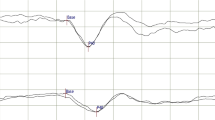Abstract
A reliable outcome measurement is needed to assess the effects of experimental lesions in the rat spinal cord as well as to assess the benefits of therapies designed to modulate them. The Basso, Beattie, and Bresnahan (BBB) behavioral scores can be indicative of the functionality in motor pathways. However, since lesions are often induced in the more accessible dorsal parts associated with the sensory pathways, the BBB scores may not be ideal measure of the disability. We propose somatosensory evoked potential (SEP) as a complementary measure to assess the integrity of sensory pathways. We used the focal experimental autoimmune encephalomyelitis (EAE) model, in which focal demyelinating lesions were induced by injecting cytokine-ethidium bromide into dorsal white matter after MOG-IFA immunization. Both the SEP and BBB measures reflected injury; however, the SEP was uniformly and consistently altered after the injury whereas the BBB varied widely. The results suggest that the SEP measures are more sensitive and reliable markers of focal spinal cord demyelination compared to the behavioral measures like the BBB score.




Similar content being viewed by others
References
National Multiple Sclerosis Society, http://www.nationalmssociety.org/index.aspx
Poser CM, Paty DW, Scheinberg L, McDonald WI, Davis FA, Ebers GC, Johnson KP, Sibley WA, Silberberg DH, Tourtellotte WW (2004) New diagnostic criteria for multiple sclerosis: guidelines for research protocols. Ann Neurol 13:227–231
Polman CH, Reingold SC, Edan G, Filippi M, Hartung HP, Kappos L, Lublin FD, Metz LM, McFarland HF, O’Connor PW, Wollheim MS, Thompson AJ, Weinshenker BG, Wolinsky JS (2005) Diagnostic criteria for multiple sclerosis: 2005 revisions to the “McDonald Criteria”. Ann Neurol 58:840–846
Hart BA, Amor S, Jonker M (2004) Evaluating the validity of animal models for research into therapies for immune-based disorders. Drug Discov Today 9:517–524
Kerschensteiner M, Stadelmann C, Buddeberg BS, Merkler D, Bareyre FM, Anthony DC, Linington C, Bruck W, Schwab ME (2004) Targeting experimental autoimmune encephalomyelitis lesions to a predetermined axonal tract system allows for refined behavioral testing in an animal model of multiple sclerosis. Am J Pathol 164:1455–1469
DeBoy CA, Zhang J, Dike S, Shats I, Jones M, Reich DS, Mori S, Nguyen T, Rothstein B, Miller RH, Griffin JT, Kerr DA, Calabresi PA (2007) High resolution diffusion tensor imaging of axonal damage in focal inflammatory and demyelinating lesions in rat spinal cord. Brain 130:2199–2210
Basso D, Beattie M, Bresnahan J (1995) A sensitive and reliable locomotor rating scale for open field testing in rats. J Neurotrauma 12:1–21
Basso D, Beattie M, Bresnahan J (1996) Graded histological and locomotor outcomes after spinal cord contusion using the NYU weight-drop device versus transaction. Exp Neurol 139:244–256
Young W (1996) Secondary injury mechanisms in acute spinal cord injury. J Emerg Med 11:13–22
Finnerup NB, Gyldensted C, Fuglsang-Frederiksen A, Bach FW, Jensen TS (2004) Sensory perception in complete spinal cord injury. Acta Neurol Scand 109:194–199
Agrawal G, Thakor NV, All AH (2009) Evoked potential versus behavior to detect minor insult to spinal cord in rat model. J Clin Neurosci 16(8):1052–1055
Dawson GD (1947) Cerebral response to electrical stimulation of peripheral nerve in man. J Neurol Neurosurg Psychiatry 10:137–140
Grundy BL (1984) Intraoperative monitoring of sensory evoked potentials. In: Nodar RH, Barber C (eds) Evoked Potentials II. Butterworth, Boston, p 624
Chiappa K (1990) Evoked potentials in clinical medicine, 2nd edn. Raven Press, New York
Nuwer MR (1998) Spinal cord monitoring with somatosensory techniques. J Clin Neurophysiol 15:183–193
Nuwer MR (1998) Fundamentals of evoked potentials and common clinical applications today. Electroencephalogr Clin Neurophysiol 106:142–148
Sherman DL, Atit MK, Geocadin RG, Venkatesha S, Hanley DF, Natarajan AL, Thakor NV (2002) Diagnostic instrumentation for neurological injury. IEEE Instru Measur Mag 28–35
Brown RH, Nash CL, Berilla JA, Amaddio MD (1984) Cortical evoked potential monitoring: a system for intraoperative monitoring of spinal cord function. Spine 9:256–261
York DH, Chabot RJ, Gaines RW (1987) Response variability of somatosensory evoked potentials during scoliosis surgery. Spine 12:864–876
Acknowledgments
The study was supported by the Maryland Stem Cell Research Fund (Grants 2007-MSCRFII-0159-00 and 2009-MSCRFII-0091-00) and the Johns Hopkins Project RESTORE fund (Transverse Myelitis Research Project). The authors would also like to thank Payal Patnaik, Sonny Dike and Michael Gorelik for providing services during the entire experiment.
Author information
Authors and Affiliations
Corresponding author
Rights and permissions
About this article
Cite this article
All, A.H., Agrawal, G., Walczak, P. et al. Evoked potential and behavioral outcomes for experimental autoimmune encephalomyelitis in Lewis rats. Neurol Sci 31, 595–601 (2010). https://doi.org/10.1007/s10072-010-0329-y
Received:
Accepted:
Published:
Issue Date:
DOI: https://doi.org/10.1007/s10072-010-0329-y




